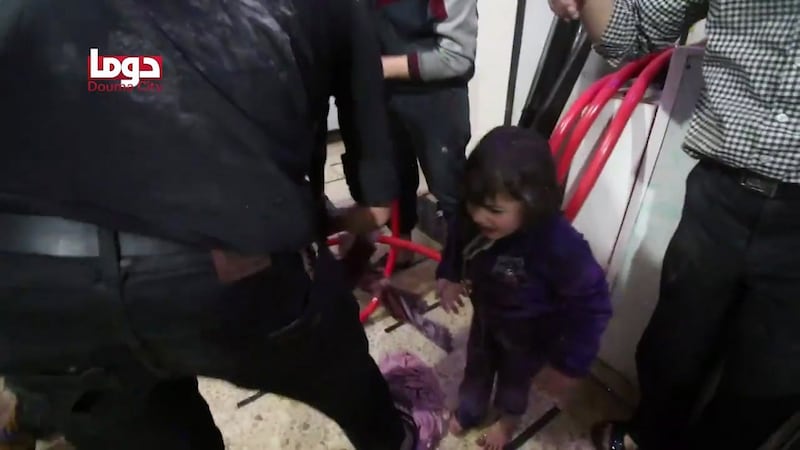Foaming at the mouth and struggling to breathe, their eyes burning, the patients overwhelmed medics in the Syrian town of Douma in the hours after 7.30pm last Saturday. By the following day, an estimated 500 people had gone to Syrian health facilities with "signs and symptoms consistent with exposure to toxic chemicals", according to reports passed to the World Health Organisation from its partners in the country.
Even in an area numbed by months of relentless attacks, this was an unusual event. Doctors were soon treating symptoms they had not seen before. Some patients were convulsing, several had pinpoint pupils, and others had slow heartbeats that were barely keeping them alive.
All complained of a pungent smell, like chlorine. That industrial chemical had been dropped on Douma and the rest of the Ghouta area many times before and doctors could easily recognise its effects. But something else was killing the people, and doctors had no idea how to treat it.
“Something was working on the nervous system,” said a doctor who asked not to be named. “Chlorine doesn’t do that. While there was clearly chlorine on some of the people we treated, there was also something else.”
In the five days since, intelligence technicians have pored over satellite images, radio intercepts and flight paths to try to establish what happened in Douma. In Jordan, officials prepared to receive biological samples from some of the estimated 42 dead and the hundreds more who survived.
Smuggling routes in and out of Damascus are well travelled, and makeshift crossings along the watertight Jordanian border can suddenly open whenever there's a need. Getting samples, especially corpses, to laboratories has been a top priority this week as the US has tried to establish if the gas that was dropped contained more than chlorine.
Blood and urine
“Blood and urine will show that for up to a week, maybe longer,” said one official who had examined samples taken from patients after the sarin strikes in Ghouta in August 2013 and in Khan Sheikhoun in April last year. “[Nerve agents] degrade very quickly in situ though. If there was going to be a productive fact-finding mission, they would need to get there immediately.”
Jerry Smith, who led the UN mission to supervise the withdrawal of the Syrian government's stockpile of sarin in late 2013, said the symptoms displayed by patients could suggest exposure to an agent in addition to chlorine.
“It’s worth elucidating the knowns,” he said. “Casualty rates, apparent speed of death and the shaking.” Organophosphate-based poison, including sarin, causes such symptoms. Pinpoint pupils and severe mouth foaming have been telltale signs in past attacks.
In Paris, London and Washington this week, intelligence agencies studied videos from the scene of most of the deaths. US officials said they seemed similar to images taken in the aftermath of the two confirmed sarin strikes, both of which had generated widespread condemnation of the Syrian regime.
By Tuesday, US officials were suggesting that the bomb that hit the three-storey residential building in Douma contained both chlorine and a nerve agent.

Military officials in all three capitals insisted the bomb had been dropped from one of two Syrian government helicopters that had taken off from the Dumayr airbase north of Douma 30 minutes earlier. Its flight path was mapped. But local spotters in Douma had logged the arrival of two helicopters. Syrian and Russian planes had been flying bombing runs over the area since Friday night.
At the same time, ground forces had been trying, without success, to break into Douma, the last opposition stronghold at the gates of Damascus (the other two strongholds in the Ghouta district had been recaptured during the previous fortnight). Douma’s resident militia, Jaish al-Islam, had defied Russian and Syrian demands to negotiate a departure.
The grand prize of reclaiming one of the last substantial chunks of the capital to remain outside state control had remained elusive. In the hours after the strike, that changed. Jaish al-Islam agreed to evacuate the area for northern Syria.
Russian troops
Russian troops entered Douma on Tuesday and inspected the house where most people died. Before they arrived, rescuers had taken videos of a large yellow cylinder on the roof of the building. The cylinder’s nose had been crushed by impact. A rooftop video taken by a first responder was corroborated by the online investigative site Bellingcat as having been taken on top of that building.
Images of a second shell taken in a bedroom could not be definitively linked to the same house. Both shells were very similar to cylinders that had been widely used in Ghouta and elsewhere in Syria to drop chlorine bombs. There were no obvious modifications to either, leaving officials in Washington and Europe scrambling to understand what could have caused such widespread death and injury.
“We’re looking at the possibility that there were separate canisters inside the cylinder,” said one regional official. “[The contents] cannot be mixed, because that would be volatile and unstable, but they can be combined. That’s a working theory – that they were in the same cylinder but kept separately. The point of detonation dispersed them together.
“We’ve seen this happen elsewhere in the country, but it didn’t cause a death toll like this. We’re in this situation because those poor people were trapped in a basement where they had no chance.”– Guardian










